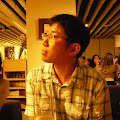 一向都是騎車路過關渡宮, 沒進去過. 元宵這天也是這個打算. 下班時甚至忘了今天是元宵節. 七點終離開辦公室後, 決定上班騎大度路, 下班騎基隆河右岸. 所以就往關渡騎去了. 到了關渡鬧區, 馬上被出巡的陣頭與炮丈聲提醒了今天是元宵. 雖是這樣, 我只想快速通過這一陣喧鬧.
一向都是騎車路過關渡宮, 沒進去過. 元宵這天也是這個打算. 下班時甚至忘了今天是元宵節. 七點終離開辦公室後, 決定上班騎大度路, 下班騎基隆河右岸. 所以就往關渡騎去了. 到了關渡鬧區, 馬上被出巡的陣頭與炮丈聲提醒了今天是元宵. 雖是這樣, 我只想快速通過這一陣喧鬧.行至關渡宮前看了一眼關渡宮前的彩燈, 商店, 人潮, 感到有一種廟會熱鬧氣氛. 不過還是沒有足以吸引我停車. 左彎上橋, 過橋, 車行又與知行路平行時忽然發現關渡宮上頭稀疏冉冉上升的天燈, 我這才停了下來. 原來這邊也有人施放天燈. 我這是第一次看到天燈. 猶豫了一下, 便回頭去尋找施放天燈的地方. 原來是在關渡宮的廣場.
廣場雖不能說人山人海, 不過也有個地方景點的小規模. 煙火, 天燈煙火販, 食物販, 圍觀者, 施放者, 香客串連起來; 煙霧迷漫, 炮聲陣耳, 讓情緒高漲了起來. 偶爾還上演小販躲警察的劇碼.
這裡的天燈施放的規模很小, 隨買隨放, 不似平溪那種龐大的天燈陣. 天燈冉冉升上時有一種寧靜自在的感覺. 逐一升起的天燈每一個都是主角; 施放者寫在燈上的願望似乎比較容易被不管是那一個神明看到.
 天燈雖帶來一種寧靜的意象, 可是煙火與鞭炮卻讓耳朵不得安寧. 煙火打上天五彩絢麗, 與寧靜的天燈形成一個對比. 不過畫面倒也是和諧.
天燈雖帶來一種寧靜的意象, 可是煙火與鞭炮卻讓耳朵不得安寧. 煙火打上天五彩絢麗, 與寧靜的天燈形成一個對比. 不過畫面倒也是和諧.人們的節慶歡樂卻是關渡自然生態的敵人. 鞭炮煙火聲嚇壞了棲息的水鳥昆蟲; 落下的天燈與鞭炮污染了濕地. 慶幸這個的活動沒有太大. 天燈煙火也只是小販與遊客間的的商業活動, 沒有組織化. 警員除趕趕擺錯位置的攤販外, 也不對這些天燈與煙火行為制止.
照片是用 SE K770i 拍的.
Sky lanterns, aka. air lanterns or Kongming lanterns, were miniature hot air balloons with paper wall and bamboo (or metal) frame. Actually, they may be the original forms of hot air balloons. It was said that the sky lantern was invented by the famous military strategist Zhuge Kongming(181-234) as a signal transmission tool in warfare.
 Nowaways, releasing sky lantern is more of a carnival activity. In Taiwan, it's one of the popular celebrations on the Lantern festival and the Mid-autumn festival. People write their wishes on the sky latnterns and release them, and hope the lanterns will carry their wishes to the gods. In Taiwan, the most famous sky lantern releasing activity is held at Pingsi on the Lantern festival. Millions of sky lanterns are released during the festival.
Nowaways, releasing sky lantern is more of a carnival activity. In Taiwan, it's one of the popular celebrations on the Lantern festival and the Mid-autumn festival. People write their wishes on the sky latnterns and release them, and hope the lanterns will carry their wishes to the gods. In Taiwan, the most famous sky lantern releasing activity is held at Pingsi on the Lantern festival. Millions of sky lanterns are released during the festival.The photos in this articles were taken in front of the Kungdu Temple of Taipei on the Lantern festival using my SE K770i. More information about sky lanterns can be easily found on the Internet.


留言